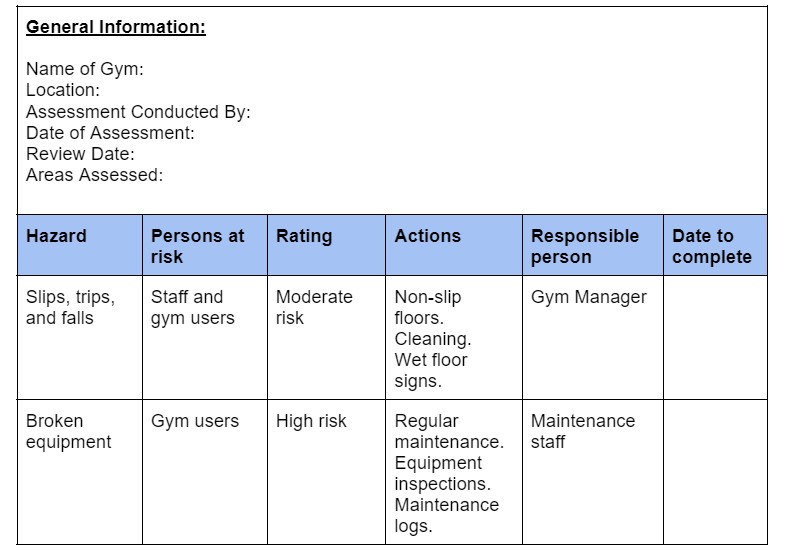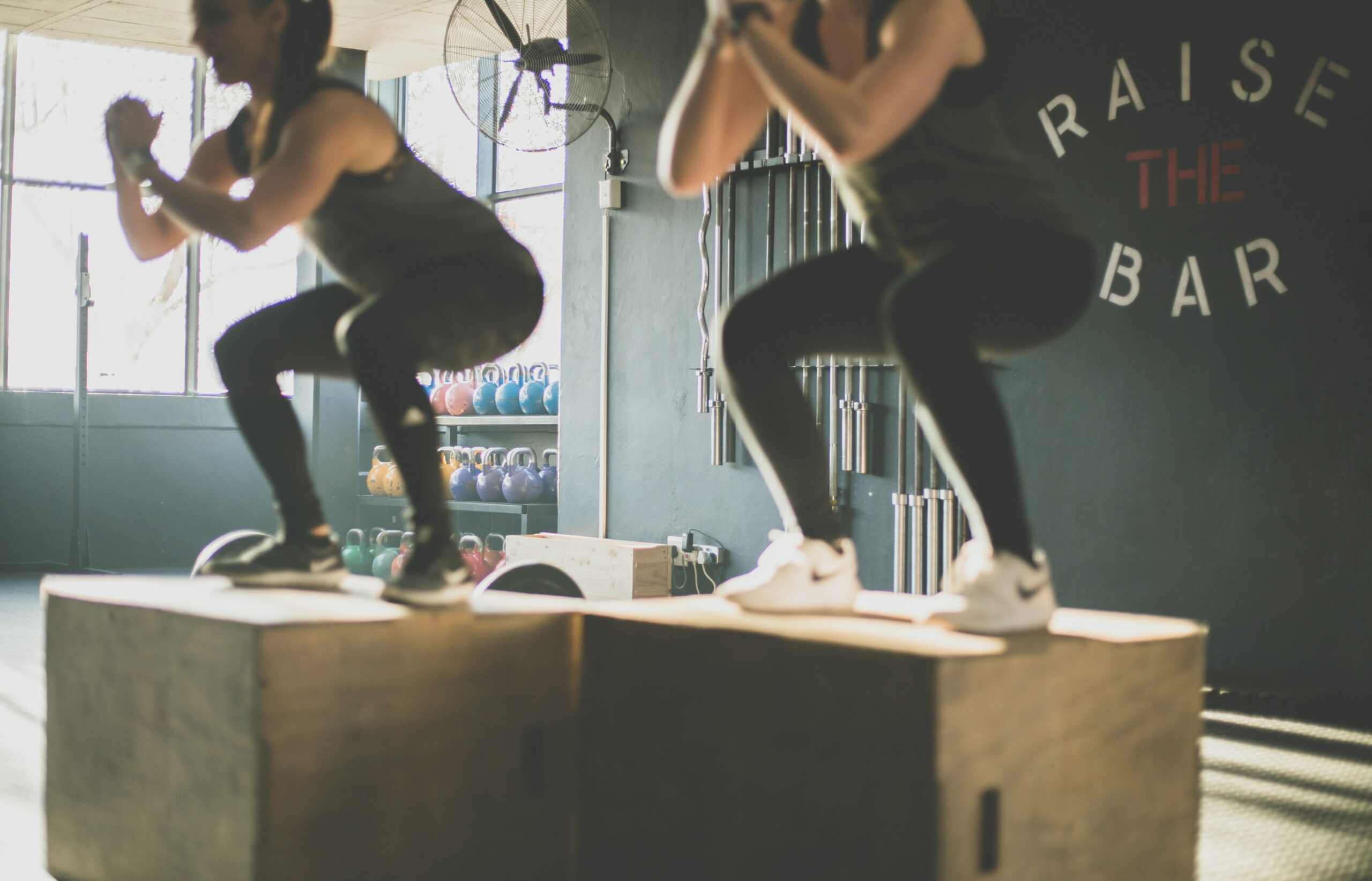Completing A Gym Risk Assessment

Gyms can be busy places, with different types of equipment, group workout classes and individuals moving around. These factors can all contribute to risks in the gym, which is why it’s important for owners or managers to complete a gym risk assessment and maintain good health and safety in the gym.
Regularly taking part in exercise is great for physical fitness and mental wellbeing. To make the experience more secure and productive for everyone, there are some essential practices and guidelines that gyms and individuals can implement to maintain optimal health and safety in the gym. Making sure that hazards in the gym are minimised means people can work out safely – and gives staff peace of mind when on the gym floor.
Risks In The Gym

There are a few common risks in the gym that can cause accidents, no matter how experienced you are. As gyms are workplaces as well as leisure and hospitality facilities, accidents can happen to both staff and members of the public. Accidents that can occur in the gym include:
Slip, Trips And Falls
Probably some of the most common accidents in any workplace, slips, trips and falls can happen in the gym due to spilled water, excess sweat, or the gym floor being cleaned without adequate signage. There may also be uneven floors or equipment creating obstacles that can cause people to trip and fall.
Falling Objects
Certain pieces of equipment, like dumbbells or ab mats may be stored at a height. If these objects fall, they could cause mild to moderate injuries to gym goers and staff alike. An accident investigation book will need to be available to record any cases of clients or staff being hit by falling objects.
Equipment-Related Injuries
Falling off treadmills, dropping weights or trapping fingers are all equipment-related risks in the gym. If equipment is not used properly and with adequate care, accidents can happen. These types of accidents can be reduced if correct training is provided to staff and customers are instructed on how to use equipment properly.
Overexertion
It’s important that gym goers take care not to lift weights that are too heavy and to only perform movements with the correct technique. Overexertion can result in a few days of muscle pain or it can have more serious consequences like sprains or even breaks.
Lack Of Supervision
Whilst users of the gym should take personal responsibility, it is also important that staff and trainers ensure people are using equipment safely and are competent at a range of exercises. This applies to those using the open gym and people in group fitness classes.
With good health and safety measures, and routine equipment maintenance, accidents in the gym can be reduced significantly. Reporting faulty equipment or obvious hazards can also help in creating a safe gym environment for everyone.
What To Include In A Gym Risk Assessment

Investing time in a gym risk assessment protects members and ensures you comply with health and safety legislation. Moreover, it makes you a responsible gym owner who prioritises the safety of staff and clients. A risk assessment for a gym can cover a number of areas, from hygiene and ventilation to equipment maintenance and member education.
A risk assessment identifies hazards and areas of concern, and sets out how these can be reduced. Gym owners can then complete method statements, which set out exactly how individual tasks should be completed. Some of the areas that should be covered in a gym risk assessment are:
Equipment Maintenance
It is imperative for gym owners and staff to regularly inspect and maintain all equipment to minimise risks in the gym related to any equipment. This includes cardio equipment like treadmills and rowers, as well as free weights, including barbells and dumbbells.
Regular inspections should be carried out to identify faulty or damaged equipment. Anything requiring repairs should be removed from use until the equipment has been fixed or replaced. There should also be clear guidelines to ensure proper usage of equipment and to educate gym goers about potential hazards in a gym.
Hygiene
The nature of the gym environment can mean that germs are spread easily. Many people come into contact with each other and use the same equipment, which can lead to the spread of infection. Regular cleaning schedules should be implemented to sanitise high-touch areas, such as exercise mats, weight benches, and changing rooms. There should also be disinfectant wipes and sprays readily available for members to wipe down equipment before and after use. These cleaning products should then be safely stored away when not in use under COSHH guidance.
Space And Ventilation
There should be enough space on the gym floor for people to work out safely without being close enough to others to cause injury. In addition, gyms will need to assess the available floor space and know how many people can safely inhabit the gym floor as part of the gym risk assessment. Not leaving adequate space between pieces of equipment can also create hazards in the gym, and there should be enough room for everyone to easily access a fire escape if a fire were to break out.
Natural airflow, air conditioning, and proper ventilation systems should be in place and detailed in the gym risk assessment, to stop the spread of airborne illnesses. It also contributes to a fresher and more enjoyable gym environment.
Educating Gym Goers
Educating both gym goers and staff about health and safety in the gym is a simple but very necessary step to minimise risks in the gym. Regular training sessions can be conducted to familiarise staff with emergency protocols, first aid techniques, and the proper usage of gym equipment. Staff may also be encouraged to undertake health and safety training, so they have in-depth knowledge of procedures, and can work with the business owners to make the gym as safe as possible.
For gym goers, signs can be displayed throughout the gym to promote safe exercise practices, proper equipment usage, and hygiene guidelines. Encouraging members to report any unsafe conditions or equipment malfunctions can help address potential hazards in the gym too.
Personal Safety
All new gym members should be given a full induction when joining so they are aware of health and safety measures, know how to conduct themselves, and can use equipment safely. The induction should also include some tips on how gym users can take care of themselves to minimise their risk of accidents in the gym. These tips might include:
- Warming up and stretching before a workout to avoid overexertion
- Staying hydrated
- Practising proper lifting techniques and avoid lifting weights that are too heavy
- Wearing appropriate clothing and shoes
- Using a spotter or asking gym staff to help
Gym Risk Assessment Template
With any risk assessment, it is useful to have a standardised document in place to speed up the process. Gym hazards might differ from hazards in a restaurant for example, but the process for creating the risk assessment will follow a similar pattern. These are typically the steps you will need to take when creating a gym risk assessment template:
- Identify the reason for the risk assessment. In this case it is to keep the gym safe for staff, gym members and any other visitors
- Gather information, for example use previous risk assessments or accident books to help you understand what can or has gone wrong
- Identify each of the gym hazards and write them down with all relevant details
- Determine who might be harmed by each of these hazards
- Evaluate the likelihood of injury and the potential consequences
- Implement control measures to minimise the risks
- Record all findings in the gym risk assessment so it can be referred back to
- Communicate to all staff so they are aware of the risks and the control measures
- Regularly review the gym risk assessment and update accordingly
As an example, a gym risk assessment template might look like this:

Additional information can be added according to the gym and any specific requirements, for example, gyms with group classes will have different risks to a boxing gym.
Gym Risk Assessments From Rhino Safety
Health and safety in the gym and gym risk assessments are crucial to establish a safe and secure gym environment. The information in the gym risk assessment may vary according to the specific gym environment – for example, a boxing gym will have different considerations to a CrossFit gym. This will inform the health and safety protocols and determine exactly what gym staff should include in member inductions.
For help understanding what to include in gym health and safety documentation, or for a full health and safety audit of your facility, please contact the team at Rhino Safety. Our experts can help you bring your gym health and safety policy up to scratch, providing staff and members with a safe and enjoyable place to work and exercise.


